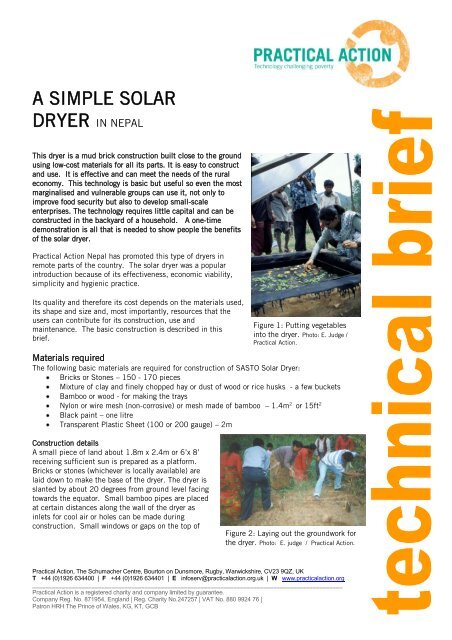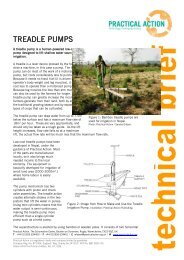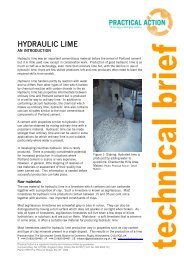A SIMPLE SOLAR DRYER
A Simple Solar Dryer in Nepal - Worldwide Helpers
A Simple Solar Dryer in Nepal - Worldwide Helpers
You also want an ePaper? Increase the reach of your titles
YUMPU automatically turns print PDFs into web optimized ePapers that Google loves.
A <strong>SIMPLE</strong> <strong>SOLAR</strong><br />
<strong>DRYER</strong> IN NEPAL<br />
This dryer is a mud brick construction built close to the ground<br />
using low-cost materials for all its parts. It is easy to construct<br />
and use. It is effective and can meet the needs of the rural<br />
economy. This technology is basic but useful so even the most<br />
marginalised and vulnerable groups can use it, not only to<br />
improve food security but also to develop small-scale<br />
enterprises. The technology requires little capital and can be<br />
constructed in the backyard of a household. A one-time<br />
demonstration is all that is needed to show people the benefits<br />
of the solar dryer.<br />
Practical Action Nepal has promoted this type of dryers in<br />
remote parts of the country. The solar dryer was a popular<br />
introduction because of its effectiveness, economic viability,<br />
simplicity and hygienic practice.<br />
Its quality and therefore its cost depends on the materials used,<br />
its shape and size and, most importantly, resources that the<br />
users can contribute for its construction, use and<br />
maintenance. The basic construction is described in this<br />
brief.<br />
Figure 1: Putting vegetables<br />
into the dryer. Photo: E. Judge /<br />
Practical Action.<br />
Materials required<br />
The following basic materials are required for construction of SASTO Solar Dryer:<br />
Bricks or Stones – 150 - 170 pieces<br />
Mixture of clay and finely chopped hay or dust of wood or rice husks - a few buckets<br />
Bamboo or wood - for making the trays<br />
Nylon or wire mesh (non-corrosive) or mesh made of bamboo – 1.4m 2 or 15ft 2<br />
Black paint – one litre<br />
Transparent Plastic Sheet (100 or 200 gauge) – 2m<br />
Construction details<br />
A small piece of land about 1.8m x 2.4m or 6’x 8’<br />
receiving sufficient sun is prepared as a platform.<br />
Bricks or stones (whichever is locally available) are<br />
laid down to make the base of the dryer. The dryer is<br />
slanted by about 20 degrees from ground level facing<br />
towards the equator. Small bamboo pipes are placed<br />
at certain distances along the wall of the dryer as<br />
inlets for cool air or holes can be made during<br />
construction. Small windows or gaps on the top of<br />
Figure 2: Laying out the groundwork for<br />
the dryer. Photo: E. judge / Practical Action.<br />
Practical Action, The Schumacher Centre, Bourton on Dunsmore, Rugby, Warwickshire, CV23 9QZ, UK<br />
T +44 (0)1926 634400 | F +44 (0)1926 634401 | E infoserv@practicalaction.org.uk | W www.practicalaction.org<br />
______________________________________________________________________________________________<br />
Practical Action is a registered charity and company limited by guarantee.<br />
Company Reg. No. 871954, England | Reg. Charity No.247257 | VAT No. 880 9924 76 |<br />
Patron HRH The Prince of Wales, KG, KT, GCB
A simple solar dryer<br />
Practical Action<br />
the wall of the dryer are placed as outlets for hot air. Clay mixed with cow-dung and finely<br />
chopped hay or rice husk or sawdust is used as mortar and plaster. This mixture is used to<br />
avoid cracks.<br />
Blackboard paint, which is non-toxic, can be used to paint the inside of the dryer, including<br />
the trays.<br />
Wooden or bamboo trays with wire or<br />
bamboo mesh are used to hold the<br />
food materials to be dried. If mesh is<br />
not available, ‘Nanglo’ (traditional<br />
bamboo sieve) can be used for this<br />
purpose after making holes in it.<br />
Transparent polypropylene plastic with a<br />
wood/bamboo frame is used to cover the<br />
dryer.<br />
The cover is made tight to prevent<br />
insects and pests getting in, and to<br />
minimise the heat loss from inside the<br />
dryer.<br />
The size and capacity of the dryer can<br />
be varied depending on need; the<br />
bigger the volume to be dried, the<br />
bigger the size of the dryer. Normally, a<br />
0.9m x 1.8m or 3’x 6’ dryer is<br />
sufficient for one household with 4 to<br />
6 family members. The trays are made<br />
to fit the size of the dryer and the<br />
depth should be limited to 7 to 10 cm<br />
or 3 to 4 inches.<br />
Precautions<br />
Care should be taken while handling<br />
the plastic cover of the dryer as it can<br />
be easily damaged. It may also be<br />
necessary to keep children away from<br />
the dryer to prevent damage. The<br />
plastic should be replaced every two<br />
months or when it is no longer<br />
transparent.<br />
Figure 3: The layout of the dryer. Illustration:<br />
Practical Action.<br />
Cost<br />
The cost is between US$5 and US$8 d<br />
in Nepal epending on the size of the<br />
dryer and the availability of local skills<br />
and materials as mentioned above.<br />
Figure 4: Laying the bricks. Photo: E. Judge /<br />
Practical Action.<br />
2
A simple solar dryer<br />
Practical Action<br />
References and further reading<br />
Drying Food Practical Action<br />
Technical Brief<br />
Solar Drying Practical Action<br />
Technical Brief<br />
Small-Scale Drying Technologies<br />
Practical Action Technical Brief<br />
Anagi Tray Dryer Practical Action<br />
Technical Brief<br />
How to Make the DRYIT Semi-<br />
Continuous Tray Dryer<br />
Practical Action Manual<br />
How to Use the DRYIT Semi-<br />
Continuous Tray Dryer Practical<br />
Action Manual<br />
Semi-Continuous Tray Dryer<br />
Engineering Drawings<br />
Setting up a Food Drying Business:<br />
Figure 5: The finished dryer. Photo: E. Judge / Practical<br />
Action.<br />
A Step-by-step Guide Fabrice Thuillier, 2002, Practical Action Publishing, ISBN<br />
9781853394980<br />
Drying Food For Profit: A Guide for Small Business Barrie Axtell 2002, Practical Action<br />
Publishing ISBN 9781853395208<br />
Try Drying It! Case Studies in the Dissemination of Tray-Drying Technology, Practical Action<br />
Publishing 1991<br />
Drying Foodstuffs Jean Françoia Rozis, 1997, Backuys Publishers<br />
Construction and Use of a Simple Solar Drier to Preserve Food for Off Season<br />
HEDON: the Household Energy Network<br />
Producing Solar Dried Fruit and Vegetables for Micro- and Small-Scale Rural Enterprise<br />
Development: A Series of Practical Guides, written by the Natural Resources Institute.<br />
Practical Action<br />
The Schumacher Centre<br />
Bourton-on-Dunsmore<br />
Rugby, Warwickshire, CV23 9QZ<br />
United Kingdom<br />
Tel: +44 (0)1926 634400<br />
Fax: +44 (0)1926 634401<br />
E-mail: inforserv@practicalaction.org.uk<br />
Website: http://practicalaction.org/practicalanswers/<br />
Practical Action is a development charity with a difference. We know the simplest ideas can have the<br />
most profound, life-changing effect on poor people across the world. For over 40 years, we have been<br />
working closely with some of the world’s poorest people - using simple technology to fight poverty and<br />
transform their lives for the better. We currently work in 15 countries in Africa, South Asia and Latin<br />
America.<br />
3





